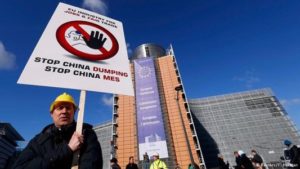Whoever feared that granting Market Economy Status (MES) to China would result in a further flooding of the European market with underpriced Chinese products, can rest easy. The European Commission has approved new antidumping legislation meant to defend the Old Continent’s manufacturing industry, which raises the tariffs for any subject, either with or without market economy status, in the case of unfair trade practices. Moreover, anti-dumping measures now consider not only value, but also social and environmental standards.
Thus, the vexata quaestio [difficult question] raised right before the deadline for reviewing China’s status as a non-market economy, was bypassed in December 2016. This represented a critical point, because the granting of market economy status to China would have meant no longer calculating dumping practices based on an analogue country methodology, but only basing it on the effective costs of the producer. A cost that European manufacturers feared, since a lack of transparency by China would have been impossible to calculate.
Thus, thanks to the demands made by a majority of manufacturing sectors in Europe, not the least of which includes footwear, the Commission reviewed the issue and approved new anti-dumping legislation that bypasses the technical question, making it applicable for all subjects, both with and without market economy status. What exactly is behind the legislation? We ask Matteo Scarparo, head of Business Services at Assocalzaturifici.
“The proposed legislation, which was amended in accordance with the parameters established also by Assocalzaturifici, was approved this past 4 December and went into force on 20 December. What changes with respect to the past? Now, the Commission can undertake an anti-dumping investigation also ex officio based on data acquired either autonomously or through the reports of third parties, including companies, trade unions and other stakeholders coming from European productive sectors. The Commission will undertake its investigation and evaluate not only value-related aspects, but also factors like respect for environmental sustainability and the cost of labour, whether or not there are government subsidies provided in the exporting country… We are satisfied with this ruling and the fact that it is neutral and does not tie into the country’s market economy status”.
The burden of proof is also eliminated…
 “After the Commission has completed its investigations and presented a report, it is possible to dispute the ruling, with the exporter having to provide proof that no unfair trade practices were undertaken”.
“After the Commission has completed its investigations and presented a report, it is possible to dispute the ruling, with the exporter having to provide proof that no unfair trade practices were undertaken”.
China does not only incite fear, but is also considered a great market for opportunity, which is becoming increasingly important for European and Italian products. What role does it play with regards to Italian footwear manufacturers?
“The Chinese market is generally stable for Made in Italy, but it is undeniable that in this moment it is going through a difficult phase for retail. It is a market that can be targeted with a mid-to-high level product and it must be approached through the digital channel. Another essential channel for entering this market is through La moda italiana @ Chic, an event realised in collaboration with Ente Moda Italia and the Shanghai ICE Agency, which sees the participation of players representing Italian apparel, footwear, and accessories”.
China lowers its tariffs on footwear imports: the reaction of Annarita Pilotti
For those operating in the promising market of China (the 11th destination for Made in Italy footwear quantities during the first six months of 2017, and the 6th when considered in combination with Hong Kong), there is more good news: this past December 2017, the Chinese government decreased the import duties on 187 products, including shoes.
The news arrived here in the West through the Chinese Xinhua agency, which is in charge of the Ministry of Finance in China, calling for a lowering of import tariffs between 17% and 7%. It is not the first time the Chinese government lowers duties. In fact, it had already done so in 2015: this further opening up of the Chinese market is in line with China’s transition from the “world’s factory” to a “market economy”. A step also motivated above all by the need to provide incentive for Chinese consumers, by reducing the cost of imported products of interest. 
The day after the announcement, Annarita Pilotti, President of Assocalzaturifici, expressed her approval: “Every measure that lowers import duties on Made in Italy footwear is welcome, because it helps our very own companies to be more competitive in a country as important as China”.
“In reality – she adds – the problems with China do not arise so much from import duties, which, at least for leather footwear that represents around 75% of Italian exports in volume, are at 10%. It is a whole other story for other kinds of footwear with fabric and synthetic uppers, which had much higher duties of 15% and 24%. There is then the question of non-tariff barriers, or rather those that are not represented by taxes paid in customs, but by mandatory technical obligations that create difficulties for Italian exporters. For example, there are footwear component standards valid only in China, which force Italian and European producers to allocate many resources in making their products compliant with the regulations of the Chinese market. These are hidden costs, which are not immediately identifiable as duties, but which nevertheless penalise Made in Italy exporters”.



